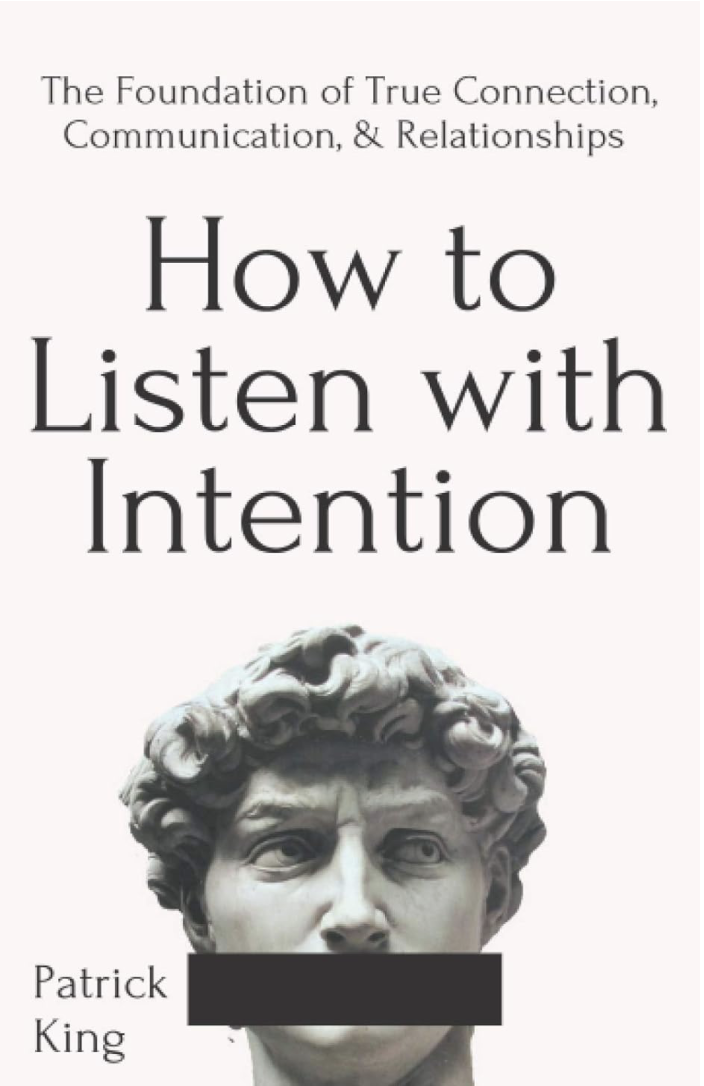INSIDER: How to Listen with Intention
Most people today are exposed to an overload of messages to which they are expected to attend and respond. For that reason, active listening is a valuable skill. With access to information instantly at our fingertips, we can find it hard to step back and really hear what someone is communicating. Patrick King’s book, How to Listen with Intention, addresses this challenge and provides helpful strategies for improving skills as listeners, communicators, and conversation partners. He breaks the book down into five sections, each highlighting one aspect of being an effective listener.
THINK POINT #1: One Mouth but Two Ears
In the first section, King highlights our neurological desire to speak more than we listen. He explains that in order to validate our conversation partners and become more interesting and likeable, we must override that instinct and take an active interest in what people say. As the chapter title suggests, he recalls the old adage that we are born with “one mouth but two ears,” and that we should be doing twice as much listening as talking. One of the ways we can do this is by using support responses during a conversation, as opposed to shift responses. A support response may be as simple as an acknowledgement that you heard the other person, such as, “that’s great,” or “uh-huh,” or possibly a way to inquire further into what they’re saying, such as asking, “What did you do next?” Alternatively, shift responses make the conversation about ourselves, and sound something like, “That’s cool…anyway, the other day this thing happened to me…” Shift responses can be appropriate and an important part of keeping a conversation moving, but when both conversation partners are using more shift than support responses, it becomes a pair of dueling monologues instead of a dialogue.
King also discusses how to navigate listening to someone who you may think is boring. In those situations, the truth is, this person isn’t boring at all! Every person you talk to has a unique perspective to offer—you just have to dig a bit deeper to find it. King suggests putting yourself in the shoes of a talk show host who is endlessly inquisitive and intrigued. For as long as a good talk show host is talking to a guest on their show, the guest is the funniest, most interesting, and most charming person in the world.
THINK POINT #2: Styles, Frames, and Levels
There are four conversational styles that King breaks down: people (emotion), content (information), action (to-do list), and time (duration and frequency). In order to effectively listen, one should recognize their own style and try to adapt to the listener’s style. King reasons that when someone communicates with you outside of giving an order or organizing an outing, they are doing so to express an emotion.
Frames are a similar concept to style, but different in that they are much more fluid. A frame simply captures someone’s overall goals and purpose for the interaction. A way that King suggests thinking about conversational frames is to think about actors in a scene, who are all working to achieve the same outcome from the conversation in order to convey a certain emotional payoff. It would be ineffective acting if they all thought the scene meant something different!
King also explains the five levels of listening as 1) ignoring, 2) pretend listening, 3) selective listening, 4) attentive listening, and 5) empathetic listening. The fifth level is ideal and describes a situation in which the listener truly listens to another with care and concern about how the speaker is feeling. Many people don’t reach the fifth level often (if ever) and tend to get stuck in levels three and four during most interactions.
THINK POINT #3: The Tough Work of Hearing Someone
Listening to someone with intention is not easy work; in fact, it can be quite tiring. If it is, that generally just means that you’re doing a very good job of actively listening to your conversation partner. If you feel that listening is an entirely passive activity, then you probably aren’t listening well enough. In order to practice the skill of active listening and take a nonpassive role in the conversation, King recommends nine types of active listening responses: comprehending, retaining, responding, restating, reflecting, summarizing, labeling emotions, probing with leading questions, and silence. Each of these are slightly different techniques that you can use to show someone that you’re not only listening to what they’re saying, but actively trying to comprehend and digest it. By implementing these techniques, you can improve your conversations and find that both you and your conversation partner get more out of the conversation.
THINK POINT #4: I See You, I Hear You
Validating a conversation partner is an important part of effectively listening and making someone feel heard. King defines validation as “the act of showing respect and acknowledgement of people’s intentions and emotions.” Doing this can be as simple as nodding along or expressing outright that their feelings are valid. Emotions are not always rational but are always real, and, as such, it is important that people feel their emotions are validated by their conversation partner.
One pitfall to avoid is using invalidating statements that make you feel like you’re helping. These can sound something like, “Oh you’ll be fine,” or, “You shouldn’t feel that way!” While one party may believe these statements are comforting, they actually imply the conversation partner’s feelings are irrational.
King’s six steps for validation are to be present, accurately reflect emotions, guess emotions, understand emotions in context, affirm emotions, and then be honest. It’s important to note that these strategies should not always be used or used in a specific order, but they can be helpful measures that facilitate good conversation and help validates what another person is trying to communicate.
THINK POINT #5: Read and Analyze
King focuses the fifth and final section of his book on emotional cues that can be used to better understand people and predict their emotional and rational states. Before diving in. however, King suggests that the most important step in understanding someone else is to first understand ourselves. King explains that emotional intelligence consists of self-awareness, self-management, self-motivation, and social awareness. He says that all of these things are important to understand, because once we know how many unconscious thoughts and motivations we have, we can start to understand that others have many that they may not even fully acknowledge. This way of thinking helps surface a significant amount of information from a small interaction.
It is also important to be aware of subtextual cues in a conversation, as they tend to be where most actual communication occurs. A mistake that most people make is to only respond to the overt words of a conversation and miss the hidden communication that can be quite revealing. A helpful way to practice responding to those covert cues can be to ask yourself, “Why did they say that, what are they feeling, and what could it mean?”
Real Estate Implications
In real estate, whether you are helping someone to buy or sell, it’s really about making connections with and understanding your clients. People are going to have many feelings and may not understand them all themselves when buying or selling a property. Therefore, it is the job of a real estate agent to dig deeper into what clients are really looking for out of the real estate transaction. The most important part of that process is being able to listen with intention, which means giving clients the floor and testing your own comprehension of what clients are saying, asking clarifying and deepening questions, validating client feelings, and watching carefully for subtextual clues in words and mannerisms.
. . . . . . . . . . . . . . . . . . .
Recommended Reading
Patrick King (2020), How to Listen with Intention: The Foundation of True Connection, Communication, & Relationships, Big Mind LLC.
. . . . . . . . . . . . . . . . . . .
About the Author
Andrew McElroy, BBA
Baylor University
Andrew McElroy graduated with a BBA from Baylor University’s Business Fellows Program in Management, Marketing, and Economics, with a minor in History and a Consulting concentration. During his undergraduate tenure, Andrew worked at Fidelity Investments in his native New Hampshire as a Business Analyst intern, where he gained experience with business reporting, data modeling, and more. Andrew currently serves as a Project Manager at Epic in Verona, Wisconsin, where he works to implement patient record software at hospitals across the country.
. . . . . . . . . . . . . . . . . . .
Download this Article
KCRR 2024 June - INSIDER How to Listen with Intention (McElroy).pdf

